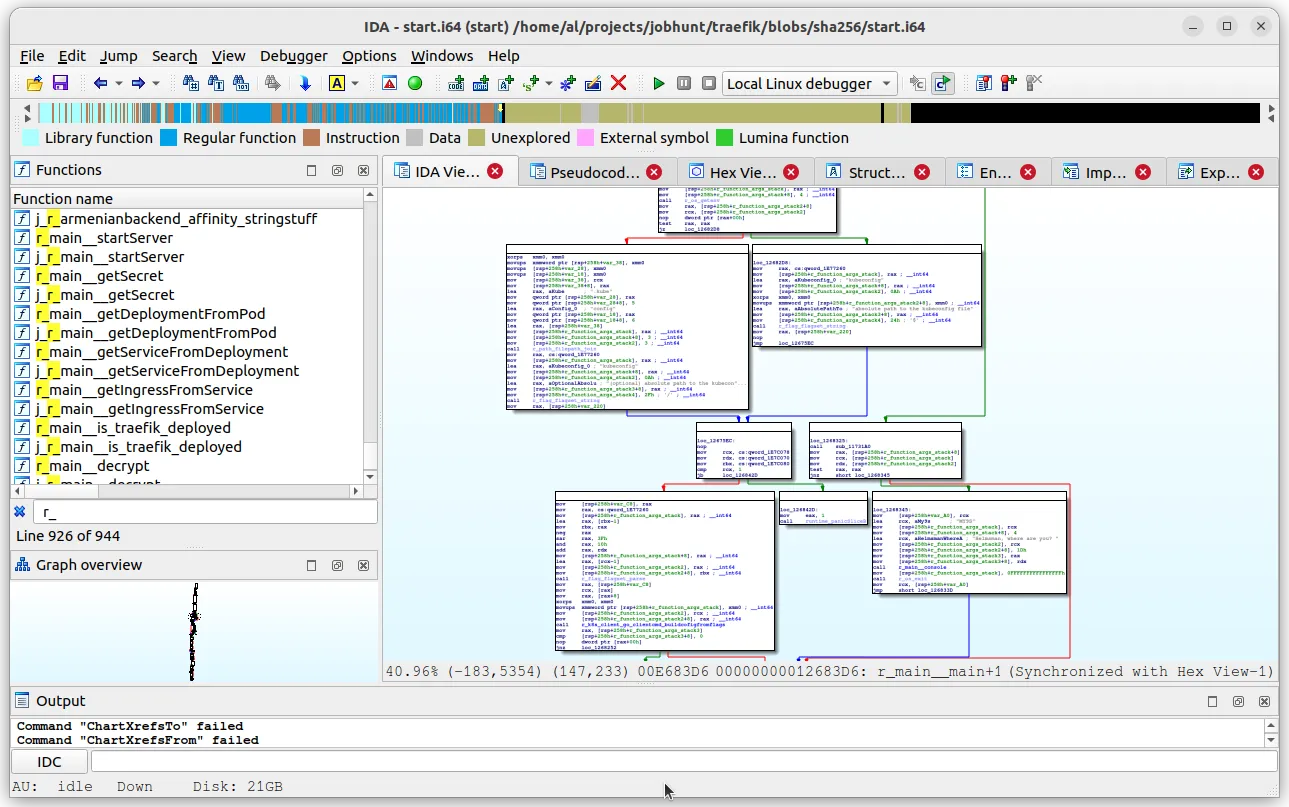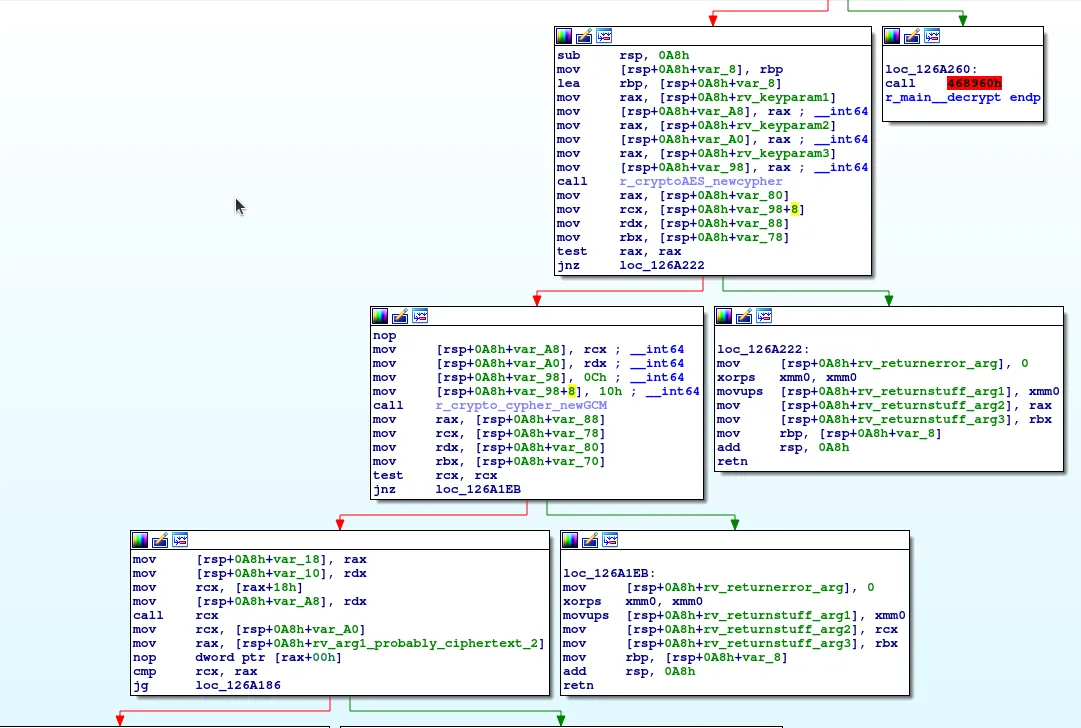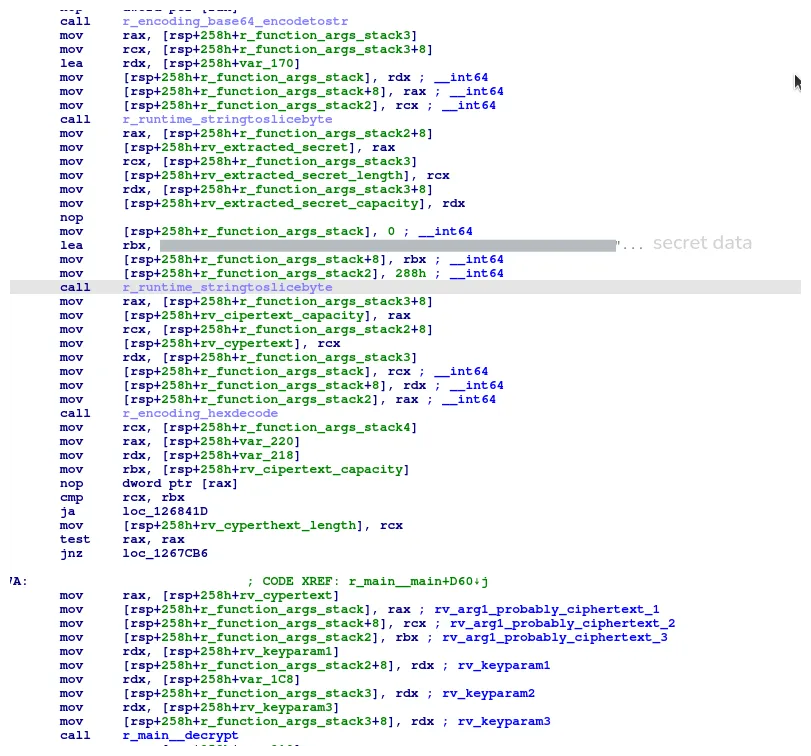Solving the challenge in traefik/jobs
The careers page on the Traefik website features an interesting code challenge that completely caught my attention. If you solve it, you will get the contact information for the job application.
# Apply here
docker run -it traefik/jobs
This is an overview of how I solved the challenge, The quick recap is:
- I extracted a Golang executable from the container, and reverse-engineered it to understand its behaviour.
- Following the code logic, I then deployed the container in a minikube cluster, with cluster admin privileges.
- When this failed due to compatibility issues (the challenge is very old), I took the path of least resistance: I extracted the secret payload from the executable and wrote a custom Golang script to decrypt it using the logic I had reverse-engineered from the challenge binary
Helmsman, where are you? - Gathering clues
Running the command provided by the challenge, a Docker image is downloaded and run. It seems to be a simple program that prints a cryptic message, then quits.
$ docker run -it traefik/jobs
> Helmsman, where are you? 🤔
By reading its dockerHub page, we learn that the image is 4 years old, and it’s called helmsman. Only two other older versions are
displayed in the tags history.
Now let’s have a look at its layers:
$ docker history traefik/jobs
IMAGE CREATED CREATED BY SIZE COMMENT
8fd1aa093b13 4 years ago ENTRYPOINT ["/start"] 0B buildkit.dockerfile.v0
<missing> 4 years ago COPY helmsman /start # buildkit 27.8MB buildkit.dockerfile.v0
<missing> 4 years ago LABEL helmsman=dcc9c530767c1020ad345d621cf29… 0B buildkit.dockerfile.v0
It’s a scratch docker image, with a single 27Mb executable.
This is very likely a medium-sized Golang application, maybe a modified version of Traefik itself.
Let’s pull it out of the image and find out.
First, we need to get a tarred copy of the image:
docker save traefik/jobs > traefikjobs.tar
These are the contents of the archive:
$ tar tfv traefikjobs.tar
drwxr-xr-x 0/0 0 2020-10-22 15:50 blobs/
drwxr-xr-x 0/0 0 2025-02-26 17:15 blobs/sha256/
-rw-r--r-- 0/0 821 2020-10-22 15:50 blobs/sha256/67f07e2ec38f4bafed8fb352fa82a8ce14b2d04b23cf17a88875ae494f1d5dc4
-rw-r--r-- 0/0 27756032 2020-10-22 15:50 blobs/sha256/852b54c4c0be1f879a3a868bb89119a68fa8a5155cec5d8e37cadba9ac38befb
-rw-r--r-- 0/0 401 1970-01-01 01:00 blobs/sha256/8d09d828807f0618cc17636a3d91a3c7d8374b89ed398b7a3cd5980e27f203e1
-rw-r--r-- 0/0 833 2020-10-22 15:50 blobs/sha256/8fd1aa093b13d1ebad4b58ab318f25e9f7d757a6cbc7391acc99518a81b5c144
-rw-r--r-- 0/0 360 2025-02-26 17:15 index.json
-rw-r--r-- 0/0 464 1970-01-01 01:00 manifest.json
-rw-r--r-- 0/0 31 1970-01-01 01:00 oci-layout
-rw-r--r-- 0/0 95 1970-01-01 01:00 repositories
We are only interested in the executable, which can be extracted from the blob with the largest size. Let’s have a look at it:
$ file start
start: ELF 64-bit LSB executable, x86-64, version 1 (SYSV), statically linked, Go BuildID=giKpqB_eEQ4pCsw_zwab/HXVXhwhlCd8onwlovFAY/b_HNul8q2i32pIwivh31/vGA8O26tkLqxQW-WXnoN, stripped
As expected, it’s a static Golang executable.
Solving strategies
To recap all the information we gathered so far:
We have a Docker image with a 4-years old Golang executable,
that expects us to provide some kind of input.
Additionally, the docker image contains a label LABEL helmsman=dcc9c530767c1020ad345d621cf29...
that looks like some kind of password we need to feed to the application.
So far this feels like a “guessy” CTF challenge, which makes me feel at home. I have enough experience to know that these challenges don’t follow the typical programming patterns of the technology they use, and because of that it’s easy to be dragged away into time-consuming dead ends.
The trick to defeat them is to base every assumption on concrete data.
For example:
The app prints “helmsman where are you?”, then quits.
Do we need to provide into its
standard input the secret label we just found?
Instead of blindly trying every idea we have, Let’s run the app with strace:
Show strace dump
$ strace -f ./start
...
snip
...
[pid 2689347] openat(AT_FDCWD, "/home/al/sandbox/start", O_RDONLY|O_CLOEXEC) = 6
[pid 2689347] epoll_ctl(3, EPOLL_CTL_ADD, 6, {events=EPOLLIN|EPOLLOUT|EPOLLRDHUP|EPOLLET, data={u32=621683704, u64=124936925357048}}) = -1 EPERM (Operation not permitted)
[pid 2689347] epoll_ctl(3, EPOLL_CTL_DEL, 6, 0xc00016dbac) = -1 EPERM (Operation not permitted)
[pid 2689347] fstat(6, {st_mode=S_IFREG|0755, st_size=27754496, ...}) = 0
[pid 2689347] pread64(6, "\177ELF\2\1\1\0\0\0\0\0\0\0\0\0\2\0>\0\1\0\0\0\200\272F\0\0\0\0\0"..., 64, 0) = 64
[pid 2689347] pread64(6, "<$H\211\\$\10H\211t$\20H\213\234$\210\0\0\0H\211\\$\30\350\2\250\377\377H\213"..., 64, 3469312) = 64
[pid 2689347] pread64(6, "\350\333\310\234\377H\211\370\350\223\311\234\377L\211\310H\211\331\350\310\310\234\377H\211\331\17\37D\0\0"..., 64, 6938624) = 64
[pid 2689347] pread64(6, "\213D$\10H\215\r\265\266Q\0H\211\214$(\1\0\0H\211\204$0\1\0\0H\215\5]\17"..., 64, 10407936) = 64
[pid 2689347] pread64(6, "\34\0H\211\4$\350\265\37-\377H\213D$\10H\213\214$\230\0\0\0H\213\224$\240\0\0\0"..., 64, 13877248) = 64
[pid 2689347] pread64(6, "`\32\222\0`\32\222\0\36:\0\0\0\200\10\0\340\32\222\0\340\32\222\0Wd\0\0\200\272\10\0"..., 64, 17346560) = 64
[pid 2689347] pread64(6, "\222\1\2&\3l\6g\5\200\1\10\t\7%\n%\2h\2%\2\261\1\7,\n\266\1\2k\2"..., 64, 20815872) = 64
[pid 2689347] pread64(6, "$\201\5\4/\2\262\5\20\205\5\4-\2\264\5)\216\1\10\2\23\36\10\225\1\33\236\1\t\301\6"..., 64, 24285184) = 64
[pid 2689347] close(6) = 0
[pid 2689348] <... nanosleep resumed>NULL) = 0
[pid 2689347] futex(0xc000088148, FUTEX_WAKE_PRIVATE, 1 <unfinished ...>
[pid 2689348] getpid( <unfinished ...>
[pid 2689347] <... futex resumed>) = 1
[pid 2689351] <... futex resumed>) = 0
[pid 2689347] futex(0x1e83cc8, FUTEX_WAIT_PRIVATE, 0, NULL <unfinished ...>
[pid 2689351] futex(0x1e83cc8, FUTEX_WAKE_PRIVATE, 1) = 0
[pid 2689347] <... futex resumed>) = -1 EAGAIN (Resource temporarily unavailable)
[pid 2689351] futex(0xc000088148, FUTEX_WAIT_PRIVATE, 0, NULL <unfinished ...>
[pid 2689348] <... getpid resumed>) = 2689347
[pid 2689348] tgkill(2689347, 2689347, SIGURG) = 0
[pid 2689347] --- SIGURG {si_signo=SIGURG, si_code=SI_TKILL, si_pid=2689347, si_uid=1000} ---
[pid 2689348] nanosleep({tv_sec=0, tv_nsec=10000000}, <unfinished ...>
[pid 2689347] rt_sigreturn({mask=[]}) = 31533280
[pid 2689347] mmap(NULL, 262144, PROT_READ|PROT_WRITE, MAP_PRIVATE|MAP_ANONYMOUS, -1, 0) = 0x71a125080000
[pid 2689348] <... nanosleep resumed>NULL) = 0
[pid 2689348] nanosleep({tv_sec=0, tv_nsec=10000000}, <unfinished ...>
[pid 2689347] write(1, "Helmsman, where are you? \360\237\244\224\n", 30Helmsman, where are you? 🤔
Since there is no report of any kind of read syscall, we can conclude that the program is not trying to read anything from the stdin,
and out initial hypothesis was wrong.
The right path: k8s
Things get much more interesting when we analyze the executable from up close:
Even when compiled into a stripped executable, Golang programs maintain several internal data
structures that expose
their original symbols.
Dumping the program into GoReSym, a tool that exploits these informations for the static analysis of Golang executables, we
get this result:
/Users/emile/go/src/github.com/traefik/jobs/cmd/helmsman/helmsman.go
main.main
flag.StringVar
flag.Parse
flag.String
main.console
main.startServer
main.getSecret
main.getDeploymentFromPod
main.getServiceFromDeployment
main.getIngressFromService
main.isTraefikDeployed
main.decrypt
main.startServer.func1
/Users/emile/go/src/github.com/traefik/jobs/vendor/k8s.io/client-go/
/Users/emile/go/src/github.com/traefik/jobs/vendor/github.com/spf13/
/Users/emile/go/src/github.com/traefik/jobs/vendor/github.com/davecgh/go-spew/
/Users/emile/go/src/github.com/traefik/jobs/vendor/golang.org/x/crypto/
/Users/emile/go/src/github.com/traefik/jobs/vendor/golang.org/x/sys/unix/
From the dependencies alone, it’s clear that this code interacts with the kubernetes API. We also have a very clear overview of the program logic, which seems to be contained in a single file. The program starts a web server, decrypts something, and interacts with a k8s cluster, checking if Traefik is deployed. Not necessarily in this order.
The hypothesis now is that if we deploy the container on a k8s cluster with the Traefik ingress controller (the best controller), we’ll somehow get our flag. The symbols we found gave us a hint of what to do, but before we spin up our k8s cluster let’s perform one extra step, and actually decompile the application.

Since the whole application logic is defined linearly in the main.main function, with no async channel crazyness,
The whole app behaviour can be read almost as easily as the original code. For example,
this is the logic that prints the message “helmsman, where are you?“. The relevant code snippets are highlighted in yellow.
There is a bit of noise originating from the Go function call ABI, but in this specific case we can ignore it.

The message gets printed when the call to k8s.io/client-go/rest.InClusterConfig fails.
Looking at its assembly, we can see the function tries to read the KUBERNETES_SERVICES_HOST env.
This is what failed when I tried to run the container without Kubernetes. It’s also worth noting that this behaviour does not generate any
syscalls; I would never have seen it with strace alone.

There is a lot of other program behaviours that can be read from the source code, including a “secret” mode for local development. I won’t spoiler these details, nor the complete behaviour, you can easily read this yourself if you follow my steps.
Deploying the container on minikube
Armed with the knowledge I gained from reversing the code, I set up a minikube cluster.
First, i wrote the manifests that defined a service account with cluster-admin privileges:
---
# this is a service account with full admin privileges
apiVersion: v1
kind: ServiceAccount
metadata:
name: traefikjobs
---
# This cluster role binding gives full admin privileges to the service account named "traefikjobs"
apiVersion: rbac.authorization.k8s.io/v1
kind: ClusterRoleBinding
metadata:
name: traefikjobs-cluster-admin
subjects:
- kind: ServiceAccount
name: traefikjobs
namespace: default
roleRef:
kind: ClusterRole
name: cluster-admin
apiGroup: rbac.authorization.k8s.io
Then I wrote the manifests for a simple Deployment, with Service and Ingress attached to the port 8888. I believe that no one enjoys reading unrequested k8s manifests, so I won’t force you to look at them unless you really want to.
See the manifests
---
apiVersion: apps/v1
kind: Deployment
metadata:
name: traefikjobs
labels:
app: traefikjobs
spec:
selector:
matchLabels:
app: traefikjobs
replicas: 1
revisionHistoryLimit: 2
template:
metadata:
labels:
app: traefikjobs
spec:
containers:
- name: traefikjobs
image: traefik/jobs
env:
- name: env
value: local
ports:
- containerPort: 8888
serviceAccount: traefikjobs
serviceAccountName: traefikjobs
---
kind: Service
apiVersion: v1
metadata:
name: traefikjobs
spec:
selector:
app: traefikjobs
ports:
- port: 8888
targetPort: 8888
---
apiVersion: networking.k8s.io/v1
kind: Ingress
metadata:
name: traefikjobs
spec:
rules:
- http:
paths:
- pathType: Prefix
path: /
backend:
service:
name: traefikjobs
port:
number: 8888
When I applied the manifests, I got this result:
# k apply -f deployment.yaml
deployment.apps/traefikjobs created
serviceaccount/traefikjobs unchanged
clusterrolebinding.rbac.authorization.k8s.io/traefikjobs-cluster-admin unchanged
service/traefikjobs created
ingress.networking.k8s.io/traefikjobs created
# k get pods
NAME READY STATUS RESTARTS AGE
traefikjobs-59b6dd7487-74979 0/1 CrashLoopBackOff 6 (84s ago) 7m13s
traefikjobs-696bb6fc8f-smxw4 0/1 Error 0 5s
# k logs -f traefikjobs-696bb6fc8f-smxw4
It seems I do need more permissions... May I be promoted cluster-admin? 🙏
Look at me by the 8888 ingress 🚪
# k get pods
NAME READY STATUS RESTARTS AGE
traefikjobs-59b6dd7487-74979 0/1 CrashLoopBackOff 6 (118s ago) 7m47s
traefikjobs-696bb6fc8f-smxw4 0/1 CrashLoopBackOff 2 (18s ago) 39s
The challenge printed the message
It seems I do need more permissions... May I be promoted cluster-admin? 🙏
Look at me by the 8888 ingress 🚪
then went into a dreaded CrashLoopBackOff.
Thanks to the reversed source code, we can see that the CrashLoop is intentional: the program intentionally calls sys.exit
after printing this message. This is not an invitation to look at it by the ingress, it’s a complaint that the main.getServiceFromDeployment function somehow failed.
The thing is, the Pod already has the cluster-admin permissions. We can confirm it by inspecting the service account, which has full access [*] to
all resources.
# k auth can-i --list --as=system:serviceaccount:default:traefikjobs
Resources Non-Resource URLs Resource Names Verbs
*.* [] [] [*]
[*] [] [*]
selfsubjectreviews.authentication.k8s.io [] [] [create]
selfsubjectaccessreviews.authorization.k8s.io [] [] [create]
selfsubjectrulesreviews.authorization.k8s.io [] [] [create]
...
There might be a lot of trivial issues I might have missed which is why, generally in life, the only way to make
sure that a pod can access the kubernetes API is to exec into the pod, and manually try
to acces them.
First, we need to replace the traefik/jobs image with a different one, possibly one that contains a shell.
kind: Deployment
...
- name: traefikjobs
image: nicolaka/netshoot
command: ["/bin/bash"]
args: ["-c", "while true; do ping localhost; sleep 60;done"]
# k rollout restart deployment traefikjobs
# k get pods
NAME READY STATUS RESTARTS AGE
traefikjobs-6bb554c655-9sb9f 1/1 Running 0 77s
# k exec -it traefikjobs-6bb554c655-9sb9f -- /bin/bash
traefikjobs-6bb554c655-9sb9f:~#
From inside the pod, we can then try to access the kubernetes API.
It’s just a matter of installing kubectl, then running kubectl auth can-i --list.
As expected, I got the same results: The Pod has admin permissions.
Taking a shortcut: static analysis
At this point it was clear that there were some issues with the challenge code, I could even see the precise point in the assembly that had the error description I needed, which sadly the program discarded before it’s stdout print.
Instead of trying to fix the Deployment, I choose to follow the path of least resistance, that in this case was the static analysis of the program.
By looking at the code, we can see that when everything is setup in the right way
the challenge will decrypt a hardcoded blob, and expose it from a web server that it launches.
The content of that blob is our objective. The function calls before the decryption, roughly speaking, look like this:
...
call r_main__getSecret
call r_runtime_mapaccess1_faststr ; args: ("helmsman")
call r_encoding_base64_encodetostr
call r_runtime_stringtoslicebyte
call r_runtime_stringtoslicebyte ; args: (0, <SECRET_ENCRYPTED_DATA>, 0x288)
call r_encoding_hexdecode
call r_main__decrypt ; args: (cyphertext, keyparam)
And looking at the function main.decrypt we can see the Complete
Decrpytion logic: It’s using the AES cypher library, in GCM mode.

We already have the encrypted blob, and the key is the one provided in the
container label: LABEL helmsman=dcc9c530767c1020ad345d621cf29...
In order to Decrypt the content we need to figure out some extra details:
- what is the nonce? And how long is it?
- what is the tag size? How long is it?
- how is the key encoded before its use?
- how is the encrypted blob encoded before its use?
The GCM parameters exposed in the first function call already answer our first questions:
mov [rsp+0A8h+var_A8], rcx ; __int64
mov [rsp+0A8h+var_A0], rdx ; __int64
mov [rsp+0A8h+var_98], 0Ch ; __int64 (12)
mov [rsp+0A8h+var_98+8], 10h ; __int64 (16)
call r_crypto_cypher_newGCM
We can see from the documentation of crypto/cipher.newGCMWithNonceAndTagSize that the 12 and 16 in the assembly are the nonce size and tag size respectively.
In order to answer the rest of the questions, we necessarily need to follow
the data flow in reverse, starting from the main.decrypt function call.
This is where some knowledge on Golang internals comes useful:
We know that aes.NewCipher(key) expects a slice as its only parameter.
So why do we see three parameters in the assembly listing?
mov [rsp+0A8h+var_8], rbp
lea rbp, [rsp+0A8h+var_8]
mov rax, [rsp+0A8h+rv_keyparam1]
mov [rsp+0A8h+var_A8], rax ; __int64
mov rax, [rsp+0A8h+rv_keyparam2]
mov [rsp+0A8h+var_A0], rax ; __int64
mov rax, [rsp+0A8h+rv_keyparam3]
mov [rsp+0A8h+var_98], rax ; __int64
call r_cryptoAES_newcypher
The answer is that the parameters keyparam1, keyparam2, keyparam3 are the slice!
respectively its pointer, size and capacity.
If we follow them upstream, we’ll reach the function arguments, which we can then label with the proper informations
mov rax, [rsp+258h+rv_cypertext]
mov [rsp+258h+r_function_args_stack], rax ; rv_ciphertext_1
mov rax, [rsp+258h+rv_cyperthext_length]
mov [rsp+258h+r_function_args_stack+8], rax ; rv_ciphertext_2
mov rax, [rsp+258h+rv_cipertext_capacity]
mov [rsp+258h+r_function_args_stack2], rax ; rv_ciphertext_3
mov rax, [rsp+258h+rv_extracted_secret]
mov [rsp+258h+r_function_args_stack2+8], rax ; rv_keyparam_1
mov rcx, [rsp+258h+rv_extracted_secret_length]
mov [rsp+258h+r_function_args_stack3], rcx ; rv_keyparam_2
mov rdx, [rsp+258h+rv_extracted_secret_capacity]
mov [rsp+258h+r_function_args_stack3+8], rdx ; rv_keyparam_3
call r_main__decrypt
Following this data upstream, we can see that the ciphertext is read from an hardcoded string,
then converted into bytes with a call to encoding/hex.Decode().
Weirdly enough, the key is not passed to hex.decode(), even though it looks like hex encoded data.
Instead, its ascii slice is directly converted into bytes.

With all these informations, we can now write our own decryption function
package main
import (
"crypto/aes"
"crypto/cipher"
"encoding/hex"
"fmt"
)
func main() {
contentHex := "SECRET_ENCRYPTED_DATA"
content, err := hex.DecodeString(contentHex[0: 0x288])
if err != nil {
panic("failed to decode content: " + err.Error())
}
keyHex := "SECRET_KEY"
key := []byte(keyHex)
block, err := aes.NewCipher(key)
if err != nil {
panic("failed to create AES cipher: " + err.Error())
}
gcm, err := cipher.NewGCM(block)
if err != nil {
panic("failed to initialize GCM: " + err.Error())
}
nonceSize := //REDACTED
nonce := content[:nonceSize]
ciphertextWithTag := content[nonceSize:]
plaintext, err := gcm.Open(nil, nonce, ciphertextWithTag, nil)
if err != nil {
panic("decryption failed: " + err.Error())
}
fmt.Printf("Decrypted data: %s\n", plaintext)
}
Running the script I successfully got this HTML code, which
contained a google form for the submission.
Note that I intentionally redacted any information that could lead to
the google form link, The only way to recover it is to follow the steps I documented.
I noticed that there are other writeups online that show a different approach to solving this challenge, so I feel like I can publish this article without spoiling the fun for anyone.
<!DOCTYPE html>
<html lang="en">
<head>
</head>
<body>
<iframe
src="https://docs.google.com/forms/_____REDACTED_____"
width="100%" height="2000"
frameborder="0" marginheight="0" marginwidth="0">
Loading...
</iframe>
</body>
</html>